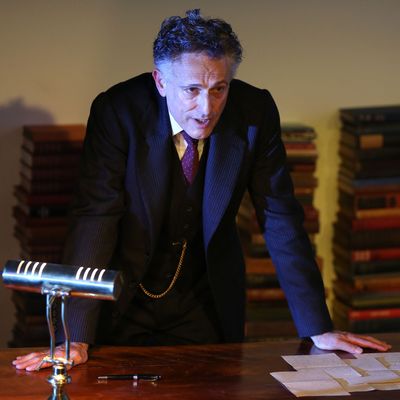
When Eugene O’Neill finished Strange Interlude in 1923, he was 35 years old, the same age as his heroine Nina Leeds in the seventh act out of nine in his paradigm-shifting, Pulitzer Prize–winning, six-hour domestic epic. “I can’t believe it,” says Nina, “I’m 35 … five years more … at 40 a woman has finished living … life passes by her … she rots away in peace! … I want to rot away in peace! … I’m sick of the fight for happiness!”
Actually, Nina doesn’t say this. She thinks it. Or, well, both. O’Neill’s innovation with Strange Interlude was to have his characters recite their inner monologues. Speakers shift seamlessly between the conversation actually at hand and verbalizations of their deepest thoughts — the latter elevating the play from a fairly typical family melodrama to a sort of psychological symphony of anxiety and desire. (The technique was so revelatory that the original Broadway production ran for 17 months, and even became a target for that highest form of flattery: a parody by Groucho Marx.) Cut everything that’s not literally spoken, and the play might last about two hours. The protracted dives into the subconscious are both Strange Interlude’s agony — in the words (and thoughts) of Nina, “No more depths, please God!” — and its ecstasy. O’Neill’s project is a kind of transcendence through endurance.
If I were a betting woman, I’d hazard that that project has never found a more fitting or fascinating expression than the production by Transport Group Theatre Company, now playing at the Irondale Theatre Center in Brooklyn. Advertised as an “almost preposterous feat” and directed with a crisp, light touch by Jack Cummings III, this Strange Interlude finds the incomparable David Greenspan — actor, playwright, five-time Obie-winner, and New York experimental theater royalty — performing all six hours of O’Neill’s epic absolutely solo. All eight characters — everything they say and everything they think (and it’s O’Neill, so they do a boatload of both) — live in Greenspan’s slight, graceful frame and his malleable, reedy voice. Audiences that go along on this epic journey follow him back and forth between three different playing spaces built within the Irondale, gradually learning the subtle shifts in his eyes, hands, and manner that signal a different character, or a shift from speech to thought.
Is it exhausting? Yes. (Probably more so for Greenspan.) Is it also utterly hypnotic, intermittently brilliant, and both a proof of O’Neill’s genius and a fascinating framing of his ideological shortcomings? Also, yes. The mad test of endurance that Greenspan has set for himself is no mere gimmick. In fact, it cracks open this unwieldy, expansive, impossible piece in ways that convinced me I never really need to see eight actors performing it.
Strange Interlude is full of references to ghosts, shadows, hauntings. A death throws its story into motion. Before the play begins, the young and beautiful Nina Leeds has lost her dream fiancé — that perfect specimen of manhood, Gordon Shaw — to a plane crash during WWI. Gordon’s ghost is the first of several to suffuse the play, and Nina’s life, like an unmoving fog. Soon enough he’ll be joined by her father and by a baby that she has aborted. Greenspan — all alone in an elegant costume by Dane Laffrey, a dark three-piece suit that calls to mind portraits of O’Neill — is a kind of ghost himself. He is both the play’s creator and its undertaker. As he flits between characters and voices, sketching them lightly in space, he might be a shadow of the author giving birth to his story, embodying the spirits that populate his own mind. Or he might be performing a kind of autopsy — deconstructing the play’s anatomy as one would a body, moving through rooms that once housed living souls and channeling the dead voices that still hang there.
Almost a century after they first resounded, these voices can still take the breath away. Especially Nina’s. She is a fascinating, infuriating creation: In her, O’Neill seems at moments to leap out of his time, and then suddenly to land back in it with a myopic, melodramatic thud. She speaks stunning lines— “The mistake began when God was created in a male image! … We should have imagined life as created in the birth-pain of God the Mother!” — and then she turns around and, as if following a textbook, enacts each step of a stereotypical, “hysterical” woman’s emotional journey, as conceived of by a man. Is O’Neill pointing the finger at the puritanical, sexist hypocrisies of his — our — society, or is he enacting them? David Greenspan’s answer would seem to be: both. His virtuosic performance, which at once embodies and dissects the play’s characters, makes a compelling case against Occam’s Razor. In this case, the most complex answer might be the right one.
The wheels of Strange Interlude start turning all because of that most terrifying of things to a patriarchal society: a woman’s sexuality. Nina, who didn’t consummate her relationship with Gordon, is consumed by frustrated desire and a twisted sense of guilt for not giving herself to her husband-to-be before his deployment. She begins sleeping with strangers in a secret, wild attempt to exorcise Gordon’s ghost. In response, the men in her life — her father; the effete, avuncular writer Charlie Marsden; the self-satisfied, pragmatic doctor Ned Darrell; and the jocular, none-too-bright admirer Sam Evans — launch a complex, subconscious, lifelong campaign to put her sexuality back into an acceptable box. They must make her into something they can understand: a wife, a mother, even a mistress (but within the rules that men have made and that society plays by).
As Strange Interlude follows the quartet (Nina, Charlie, Ned, Sam) over 25 years, Nina marries Sam, she has Ned’s baby, she names the baby Gordon and passes it off as Sam’s (speaking of ghosts, there are heavy shades of Ibsen in the sensational twists and turns that make such a scheme necessary). She lives through the loss of her husband (he dies), her lover (he leaves her), and her son (who leaves her, too, for a wife of his own). In the final act she turns to “dear old Charlie,” who has waited in the shadows for a quarter century, and now lays claim to her in the evening of their long day. The men around her want to possess her, and Nina gives each of them his chance. She moves among them in a kind of exhausting dance, set to the repeated, excruciating refrain of the Pursuit of Happiness. It’s a kind of American nightmare: Our national obsession with personal happiness — our conception of it as an inalienable right — drives us to lead lives that, consumed by the anxiety of the pursuit, never come close to achieving the goal.
The brilliant idea that Greenspan and his director have here is to do with O’Neill what O’Neill’s men would do with Nina: They put Strange Interlude into a box, thereby letting us observe it as a kind of living artifact. Laffrey, also the scenic designer, has built a literal plywood box inside the Irondale’s vast, gymnasium-like space. This theater-within-a-theater contains the production’s three playing spaces, and as you approach it from the outside, you get the sense that you’re entering a kind of diorama, or perhaps even a coffin. Inside the box, and eventually atop it, Greenspan dances with the ghosts of a 94-year-old play and a 129-year-old playwright. In a single body and a single voice, he reveals the extraordinary combination of startling progressiveness, sexist melodrama, cosmic poetry, and pure camp at the heart of O’Neill’s play. His Strange Interlude becomes a body turned inside out — a dated domestic drama with its bloody, complex musculature exposed. Here, it seems Wordsworth’s famous idiom was wrong: Greenspan’s dissection is not murder but a kind of resurrection.
Strange Interlude is at the Irondale Theater Center through November 18.


